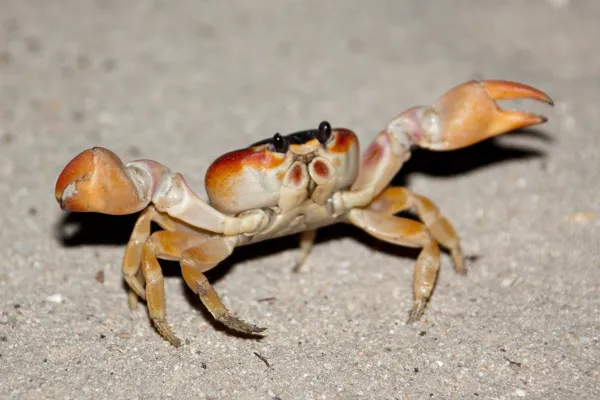Is the crab a vertebrate or invertebrate?
In both deep oceans, rivers and lakes, as well as terrestrial environments, crabs have established their presence in astonishing ways. These crustaceans, members of the extensive phylum Arthropoda, are distinctive for their dexterous pincers and unique body structure, as well as their way of moving. There is a great diversity of crab species, from small hermit crabs to large Japanese crabs, each with peculiarities that make them unique. From their moving eyes to their articulated appendages, each trait tells an intriguing evolutionary story that defines them.

Is the crab a vertebrate or invertebrate?
The fundamental characteristic that distinguishes invertebrate animals from vertebrates is the lack of a vertebral column. While vertebrates, such as fish, birds, mammals and reptiles, have a vertebral column that protects the spinal cord, crabs and other invertebrates lack this internal bone structure. Therefore yes, the crab is an invertebrate rather than a vertebrate.
Crabs, like other invertebrate arthropod animals , have an external exoskeleton. This exoskeleton is a rigid, protective layer composed primarily of chitin, which provides structural support to the crab’s body. The need to shed the exoskeleton as the crab grows is a common characteristic of arthropods.
Invertebrates are a diverse group that encompasses a wide variety of shapes and sizes. Crabs, for example, exhibit great morphological diversity and occupy a variety of habitats, from marine to freshwater and terrestrial environments. Their adaptability allows them to colonize a variety of ecosystems.
Although invertebrates lack a backbone, many of them, including crabs, have highly developed nervous systems. These systems allow them to perceive their environment, make decisions and respond to stimuli effectively.
Why is the crab an invertebrate?
As we mentioned before, the crab is an invertebrate due to the absence of a vertebral column. This anatomical characteristic distinguishes it from vertebrates, since it lacks an internal structure that protects the spinal cord.
Crabs have an external exoskeleton composed primarily of chitin, which provides support and protection, but does not serve the function of a spinal column. It belongs to the phylum Arthropoda, a group that includes numerous invertebrates.
The morphological diversity and adaptability of crabs to diverse environments, as well as their evolutionary success, are due to their status as invertebrates. Phylogeny studies support this classification, placing crabs within the broader group of invertebrate arthropods.
They have unique characteristics that vary by species, while others are general to all crab species.
- They have an external exoskeleton : which is mainly composed of chitin. This exoskeleton provides structural support and protection, but must be shed periodically as the crab grows.
- They have articulated appendages : which include legs and pincers adapted for various functions. These appendages allow them to walk, dig, grab food, and defend themselves from predators or competitors.
- Like other arthropods, the body of crabs is segmented into distinct regions: such as head, thorax and abdomen. Each segment fulfills specific functions and contributes to the mobility and versatility of the crab. Many crabs have mobile eyes, allowing them to scan their environment and detect potential threats or prey. The ability to move your eyes increases your field of vision.
Likewise, it has antennae as sensory organs that help the crab detect chemical substances in the water and explore its environment. These antennae are also useful for communication between individuals of the same species. Crabs have a well-developed digestive system with specialized structures for crushing and processing food.
Their diet can vary and may include plant matter, small animals, detritus and other aquatic organisms. Most crabs breathe through gills , specialized structures that extract oxygen from the water. Some species can also perform gas exchange through modified lung structures.
These general characteristics are representative of crabs in general terms, but it is important to note that there is a great diversity of crab species with specific adaptations to their particular environments.
Classification of crabs
Crabs are classified within the phylum Arthropoda , which groups invertebrate organisms with a chitinous exoskeleton and articulated appendages. Within the phylum Arthropoda, crabs belong to the subphylum Crustacea , which includes crustaceans such as lobsters, shrimp, crabs, and barnacles.
Below, we provide you with a classification of crabs:
- Kingdom: Animalia (Animals).
- Phylum: Arthropoda (Arthropods).
- Subphylum: Crustacea (Crustaceans).
- Class: Malacostraca (Malacostraceans).
- Order: Decapoda (Decapods).
- Suborder: Pleocyemata (Pleocyematos).
- Infraorder: Eubrachyura (Eubracuros).
- Superfamily: varies depending on the specific family of the crab.
- Section: Dromiacea.
- Raninoida.
- Cyclodorippoida.
- Eubrachyura.
- Family: varies depending on the species of crab.
More specific classification, such as family and species, varies depending on the type of crab. For example, hermit crabs belong to the family Paguridae, while crayfish can be classified into families such as Potamidae.
It is important to note that there are numerous species of crabs with various characteristics and adaptations that have developed to occupy different habitats, whether in marine, freshwater or terrestrial environments. Therefore, the exact classification may vary depending on the specific species of crab we are considering.
